Instructions on how to make a rock garden with your own hands
There are many ways to make the space near your own home harmonious, comfortable and cozy. One of the most interesting is to create an unusual rock garden with your own hands. Let's see what it is, what philosophy is in it, according to what principles to equip it, as well as how to properly care for it. We will also get acquainted with other types of stone gardens that will decorate any summer cottage.
Origin story
The stone garden is a heritage from the Orient and is an integral part of the art of Zen Buddhism. This Japanese landscape decoration creates a pleasant atmosphere of harmony and absolute relaxation.
It appeared in antiquity, in the Muromachi period. In the land of the rising sun, the stone was an object of worship. According to the philosophies of Confucianism and Zen Buddhism, it is endowed with powerful energy that embodies harmony, serenity and tranquility.

It is known by two names in Japan. Karesansui literally means "mountains and dry waters", and "sekitei" means stone garden.There is a legend about a sailor who saved a turtle. As a sign of gratitude, she showed him one of the three or five islands where the immortals live. Hence the requirement for the number of stones - three or five - but in any case the number must be odd.
Initially, small stone compositions were installed on the territory of Japanese monasteries. Later they became a unique element of landscape design.
Basic design principles
When designing a stone garden in the country, several basic principles should be taken into account:
- The stone composition is oriented around a point of contemplation. It should be chosen depending on what time of day a person prefers to relax in the garden.
- The number of large stones must be odd.
- Stones of different sizes (large and medium) can be arranged in compositions consisting of three pieces. However, a clear sequence is not required.
- It is important to maintain a balance between filled and empty areas. It is unacceptable to pile stones. Green plants and small pebbles should be used to fill the space between the large stones.
- In the central part of the composition, asymmetry is encouraged.
- Regardless of their shape and size, stones should have the most natural and natural appearance. Sharp-edged specimens should look like they've come off a cliff, and smooth, rounded specimens should resemble the seaside.
- Most stones are positioned horizontally, not vertically.
- Ideally, the composition consists of three harmonious planes - foreground, middle and background. The most beautiful and expressive rocks should be placed in front. In the middle, it is nice to have pebbles and at the back, to lay out a path that leads into the distance.

How to choose stones
When choosing stones to create a Japanese stone garden, you should consider several important points:
- Natural and natural look. The presence of moss on the surface of the stones, traces of leaching is favoured.
- A single color palette, which can be light or dark, depending on your personal preferences. It is not recommended to mix specimens of different colors and shades with each other. An exception is pebbles, which can be lighter in color compared to larger stones. Bright colored stones are not suitable for such compositions.
- The texture of the selected stones must also be in harmony. Instances with smooth and rough and porous surfaces cannot be combined with each other.
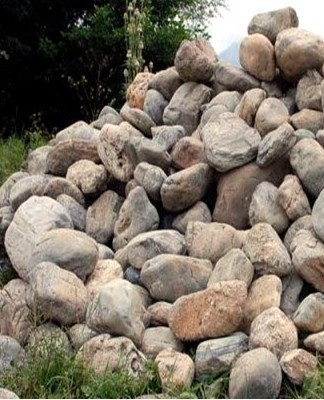
Service request
To make a beautiful and harmonious rock garden yourself, you need to follow a certain sequence of work:
- Choose an appropriate site.
- Draw the contours of the future stone composition using sharp dowels and a taut rope. There are no rules regarding the choice of the shape of the garden, it can be arbitrary.
- Level the base and, using a bayonet shovel, carefully remove the top layer ten to fifteen centimeters thick.
- Pull the roots of weeds out of the ground. Then moisten the soil and leave in this state for a week. During this period, weeds can sprout, which at first went unnoticed.
- In addition, carry out soil treatment with effective herbicidal preparations.
- Drain the soil to ensure better water drainage.To do this, a site is dug up and baking powder is added to the composition of the soil - it can be brick or granite chips, or means such as vermiculite and expanded clay.
- In the event that you plan to plant plants, it is advisable to add peat and fertilizers to the soil.
- Lay geotextiles at the bottom of the prepared trench. Its important property is to suppress the growth of weeds.
- Spread a layer of sand (pillow) at least five centimeters thick.
- Evenly cover the area with gravel or pebbles to ground level.
- Make footprints to place rock stones.
- Using a pre-prepared project, place stones on the territory.
- Pour water on gravel or pebbles to ensure better removal. For every square meter - a bucket of water.
- Using a rake, create an imitation of waves on the surface of the pebbles.
- If desired, arrange a small border around the edges of the stone garden, which will prevent accidental washing of the pebbles.
Selection of plants
To make the space more lively, harmonious and attractive, it is necessary to choose the right plant cultures, combined with stones.
Most of all, undersized options are suitable for these purposes, which can be planted singly or in small groups.
The ideal choices for a rock garden are:
- thuja;
- if;
- junipers;
- dwarf mountain ash, pine, willow and birch;
- barberry;
- dogwood.
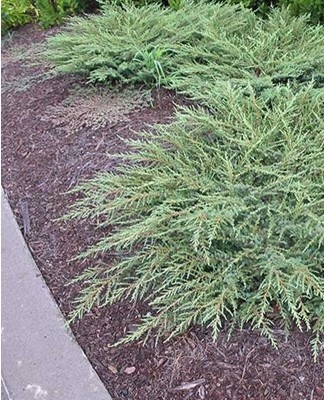
Among the herbaceous plants suitable are:
- crocus;
- alpine edelweiss;
- forget-me-not;
- geranium;
- Iberis;
- cereals;
- ground cover crops;
- saxifrage.
Crop planting should be done before the site is covered with gravel, rubble or pebbles.
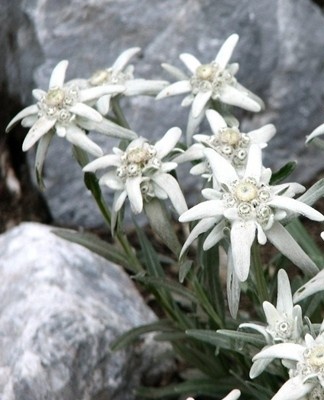
Use of tank
A small pond, nicely framed with stones, will make the space more harmonious and serene.
To create it correctly, you must:
- Choose a suitable location on the site. Large trees and other plantings should not be placed near the future reservoir.
- On the surface of the earth, outline the desired shape of the tank according to the plan.
- Mark the outlines by driving in sharp stakes and pulling on the rope.
- Dig a hole at least half a meter deep. In this case, its shape can be arbitrary.
- Pull out the weeds with the roots and compact the soil.
- Add a 10 cm layer of sand and tamp everything down again.
- Achieve effective waterproofing using PVC sheeting or durable butyl rubber. Outside the future tank, the waterproofing material should extend for about half a meter on all sides. You can disguise and decorate this element by laying well-chosen pebbles around the tank.
- The last stage of the arrangement is to plant plants and fill it directly with water.
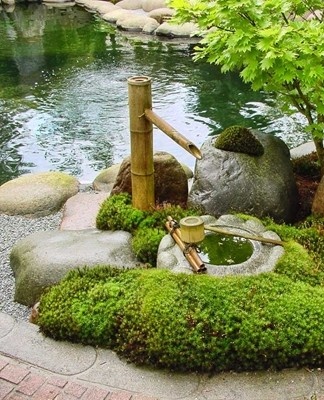
Additional decor
Well-chosen decorative elements will decorate the landscape and make a harmonious company of stone blocks.
stone lanterns
Stone lanterns are a popular landscape feature in Japan. They consist of a base, a stand, a light box, a light box stand and a roof. There is a small candle inside the light chamber, whose flame sways and creates an atmosphere of mystery.

Bridges
The most relevant are the bridges in the garden, where there is a small reservoir. Stone or wooden specimens are attractive.
Opaque fences
Fences made of opaque materials are essential to create an intimate, intimate, calm and serene atmosphere.
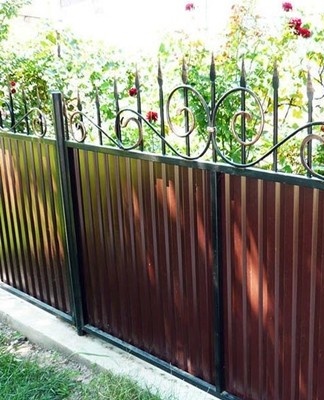
Tskubai
Beautiful traditional Japanese bowls of low height, made of stone, are called tskubai.Now they are assigned the role of decoration and decoration, but in the old days they were used for washing hands.
Topiary objects
They will complement the rock garden and make it more beautiful and lively, skillfully cut green figures in the bushes.
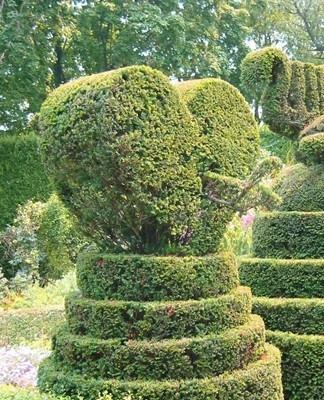
Rules of care
In order for the rock garden to be pleasing to the eye and not lose its unique aura, it is important to properly and regularly care for it.
Garbage collection
The gravel cover of the rock garden is often dirty. To clean it, it is advisable to use a metal rake and a hard bristle brush. If the gravel is not sufficiently compacted, remove the debris by hand.
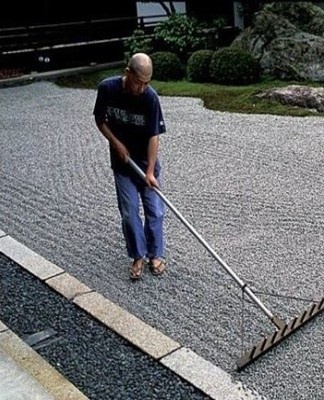
weeding
Regular weeding will eliminate weeds and prevent new growth.
Take care of plants
Plants planted in a rockery need thorough regular watering. At first, they require a large amount of moisture. In the future, the frequency of watering should be reduced. To avoid problems, it is recommended to give preference to plants that are easily drought-tolerant and undemanding to the quality and composition of the soil.

Alternative Types of Stone Gardens
Let's get acquainted with the most popular and spectacular varieties of stone gardens.
rock garden
Rockeries are miniature replicas of the natural rocky landscape. If there are no natural slopes or hills on the site, then you have to build them yourself. Another name for this landscaping element is a rocky hill.
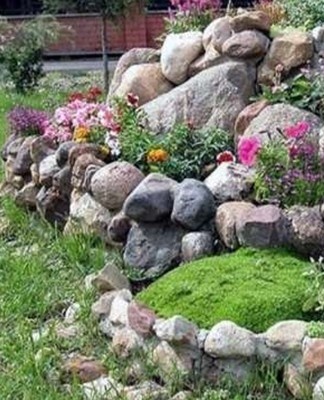
rock garden
Unlike a rockery, a rockery does not need a slide. It is characterized by a uniform relief and small size.
leaned
The stone terraced garden has horizontal walls and terraces.It combines the features of a rockery, stone steps and retaining walls. Most suitable for arrangement in areas with difficult terrain.
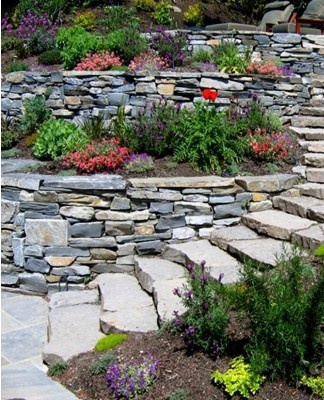
Gravel
This option looks like a classic Japanese garden, but there are no rocks. Only gravel, flowers and evergreens, planted in random order. Most suitable for compact areas.
Imitation of natural landscape
An imitation of natural mountain landscapes looks advantageous at the summer cottage. This will require large beautiful stones, an abundance of greenery and garden decor items. All elements are placed in no particular order.

mini-garden
A mini stone garden is suitable both in city apartments and in summer cottages. To create you will need a medium-sized pot, some pebbles and dwarf evergreen plants.

Examples of ready-made solutions
Those who want to arrange a beautiful stone garden on a summer cottage or personal plot should pay attention to famous examples.
The rock garden of the Reanji Temple, created in Kyoto in the XIV-XVI centuries, is in the form of a rectangular area, densely filled with gravel. On the surface there is an imitation of waves and fifteen stones are placed, divided into five groups.
The Zen garden on the outskirts of the Czech spa town of Karlovy Vary was created in 1998. The composition in the shape of a circle divided by a center line is the work of architect Kinji Nomura. The white gravel symbolizes the ocean. A stone has the shape of a ship. In the central part of the composition is a lantern symbolizing light and help to those who have gone astray.



